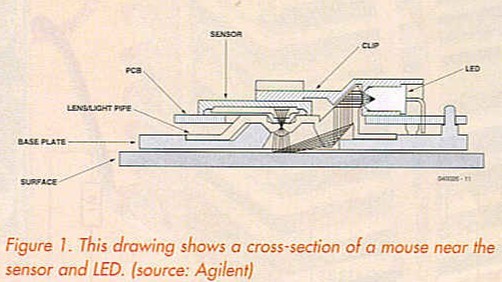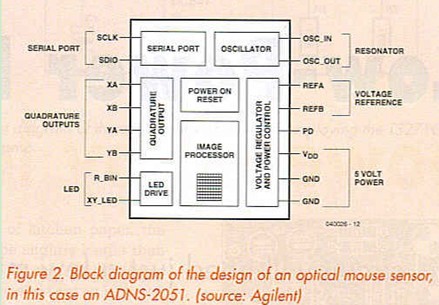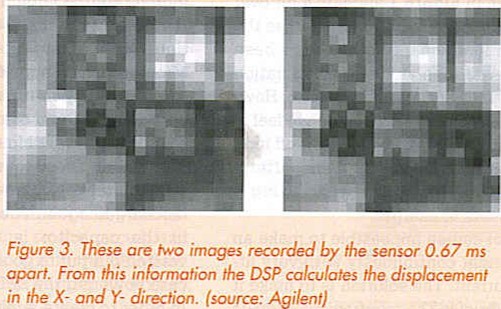

Project Solutions
Of Mice and Light
Published:2011/7/26 21:43:00 Author:Phyllis From:SeekIC
increased accuracy without mechanics
By Harry Baggen
These days, no one is surprised any more about a mouse without a ball, although optical mice have been around for only a few years. Meanwhile, optical sensors have evolved to the point where they can easily compete with the accuracy of a mechanical assembly. In fact, they are often even more accurate and react quicker.
Nowadays a personal computer without a mouse is practically unimaginable. So many operations are carried out with the mouse that using Windows, for example, with the keyboard only is next to impossible, because you are constantly moving over a graphical desktop. That the (optical) mouse has become an essential part of any modern PC is confirmed by the large numbers sold. The largest manufacturer of optical mouse sensors, Agilent (the former component division of HP), has sold more than 200 million units since the introduction of the first sensor in 1999! In addition, there are several other manufacturers of these types of sensors and mechanical mice continue to be produced in large quantities.
The major advantage of the optical mouse compared to its mechanical counterpart is the virtual immunity to dirt and dust. Cleaning of the ball and rollers is a thing of the past. None the less, there are (or were) disadvantages. The first optical mice were slow to react, inaccurate and power hungry. These problems have now all been solved, so only the advantages remain. There is still one small weakness: an optical mouse does not work well on some surfaces, because it cannot find enough identifying marks. However, this problem is easily solved with another mouse mat.
As a result of falling sensor prices and the simple construction of the sensor (practically everything, except the LED, is accommodated in one IC) the mechanical mouse is now slowly disappearing from the retail shelves.
Camera and DSP
At first glance, it would seem easy to detect the movement of the mouse using an optical system. But behind this simple idea hides some complex electronics that’s comparable to a simple video camera combined with an intelligent digital movement detector. Figure 1 shows a cross-section of the mouse near the optical sensor. All the electronics, including the ’camera’ part and the lens, are contained in a single IC labeled sensor in the diagram (Figure 2 shows a block diagram of the IC). An LED next to the IC provides for sufficient illumination of the surface over which the mouse is moved. The sensor catches some of this reflected light and translates it into an image. The camera section is relatively small, usually only 2020 or 30_30 pixels. These generate a black-and-white image for the image-processor (a DSP), which repeatedly performs a pattern analysis and compares this with the previous pattern. Using patented technology, the DSP can deduce in an instant in which direction the pattern is moving and at which speed. Figure 3 shows two images separated in time by about 0.7 ms. The processor recognizes similar patterns in each of these images and uses these to calculate the displacement in the X- and Y-direction. 


Modern sensors have a resolution of 400 or 800 CPI (counts per inch) and reach unbelievably high processing speeds of around 2500 frames per second. This makes movement speeds of up to 12 inches (approx. 30.5 cm) per second possible! Wireless optical mice use special techniques to reduce the power consumption as much as is possible. For example, the frame-rate is reduced when little movement has been detected.
Finally, a quick look at the output signals produced by the mouse sensor. The cheaper sensors are limited to a serial output, which transmits the X- and Y-displacement data to a processor in the mouse for further processing. Larger sensors often have additional quadrature outputs, which provide signals similar to a mechanical mouse. In principle you could use such a sensor to modify an existing mouse yourself...
Reprinted Url Of This Article: http://www.seekic.com/blog/project_solutions/2011/07/26/Of_Mice_and_Light.html
Print this Page | Comments | Reading(530)
Article Categories
New published articles
· Imagination works with TSMC to develop FinFET process
Author:Ecco Reading(32821)
· XMOS pushes event-driven MCUs with lower price
Author:Ecco Reading(3526)
· Intel brings upgraded 32-nm SoC for smartphones
Author:Ecco Reading(3246)
· Micron pushes TLC 128-Gbit NAND flash
Author:Ecco Reading(3801)
· Intel will stop supplying desktop motherboards
Author:Ecco Reading(5331)
· Processor market was expected to regain strength in 2013
Author:Ecco Reading(3315)
· It was reported that TSMC sales fall steeply
Author:Ecco Reading(3462)
· Cisco, NXP work with auto wireless startup
Author:Ecco Reading(3604)
· Micron was impacted by manufacturing glitch
Author:Ecco Reading(4009)
· China can make 22-nm transistor by themselves
Author:Ecco Reading(3807)
· Chip market rebound is coming, according to survey
Author:Ecco Reading(3748)
· Sony, Toshiba will spend more on chips, iSuppli reports
Author:Ecco Reading(3780)
· Qualcomm becomes the 13th company to join NFC Forum board
Author:Ecco Reading(6094)
· TSMC increases building work for FinFET fab
Author:Ecco Reading(3764)
· TI plans to cut 1,700 jobs in OMAP shift
Author:Ecco Reading(4579)